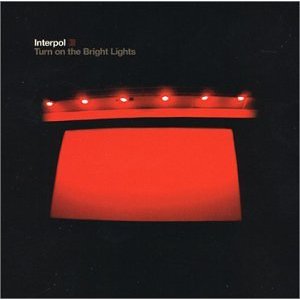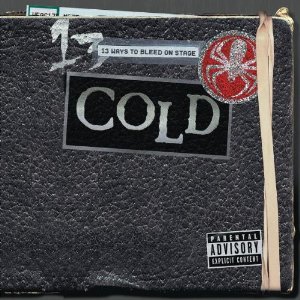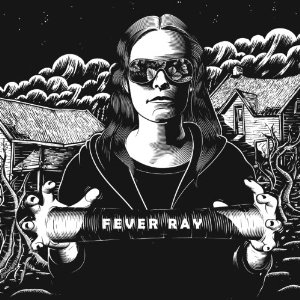80. PJ Harvey Stories From The City, Stories From The Sea (2000)
79. No Doubt Rock Steady (2001)
Throughout the late 1990s, No Doubt established itself as a hit-generating power pop combo blending rock trends of the day with the band’s ska roots. So it was somewhat unexpected when the band returned with what was essentially a dance album. It was a definite change of gears, but they pulled it off: Rock Steady peaked at #9 on the Billboard album charts, eventually going double platinum. The album also yielded three hit singles in “Hey Baby” (#5), “Hella Good” (#13) and one of 2002’s biggest singles, “Underneath it All” (#3). Rock Steady‘s departure from the pop rock sound that the band had cultivated over the last decade was in part due to the many collaborators who helped to shape the album. Collectively, The Neptunes, Sly & Robbie, William Orbit, Nellee Hooper, Prince (then known as “The Artist”) and Ric Ocasek created a diverse musical palate that somehow managed to maintain its consistency throughout. Personally, I wasn’t all that taken with the album upon release, but a decade later, it’s become my favorite of No Doubt’s offerings, as it’s somehow managed to avoid sounding terribly dated. Curiously, it sounds more current in 2012 than Gwen Stefani’s solo debut from 2005. Dr. Gonzo
 78. Interpol Turn On The Bright Lights (2002)
78. Interpol Turn On The Bright Lights (2002)
Coming out of seemingly nowhere in 2002, Interpol’s debut album Turn on the Bright Lights was at once refreshing and nostalgic. The post-punk wave of NYC-based acts had already kicked off the previous year with the debut from The Strokes, and Interpol hit almost as hard with this collection of atmospheric, moody songs that recalled bands like Joy Division and Echo and the Bunnymen. Singer Paul Banks’ baritone was a distinctive identifier for the band, especially on “PDA,” “NYC” and “Say Hello to the Angels.” Interpol used chiming guitar patterns and the strong rhythm section of Carlos Dengler and Sam Fogarino to propel its songs forward, bringing an ‘80s aesthetic into the ‘00s. The band also set itself apart by dressing in designer suits as opposed to the jeans and leather jacket look of The Strokes. A commercial and critical success, Turn on the Bright Lights was an instant classic, but unfortunately Interpol has struggled with its subsequent efforts to top or even come close to matching it. There’s no denying, however, that Turn on the Bright Lights deserves to be placed among the top albums of the decade. Koomdogg
77. Mastodon Leviathan (2004)
This is the one that did it, folks. Leviathan ingrained Mastodon into the psyche of every metal head (myself included) when this was unleashed on August 31st, 2004. Highbrow metal at its finest, Leviathan followed Mastodon’s concept album trend with an album focusing on water and Moby Dick in particular. Starting with the anthemic “Blood And Thunder” (featuring Clutch’s Neil Fallon), Leviathan is an album that needs to be listened from start to finish uninterrupted but it is definitely enjoyable if you have ADD too. The highlight is “Hearts Alive”, an almost 14 minute maelstrom of guitars and drums that sees drummer Brann Dailor go off the deep end along with Brent Hinds and Bill Keliher delivering some killer headbanging riffage. Jesse
The music world was rocked to its foundation on February 10th, 2006, when the brilliant James Yancey, AKA J Dilla, succumbed to the blood disease TTP. A career and life cut way too short, we can only wonder what could have been had he not passed so early. Just three days prior, Dilla celebrated both his 32nd birthday and the release of his ground-breaking instrumental album, Donuts. Named for his love of the fatty yet tasty treats, Donuts (the album), like its counterpart, is both phat and sweet, supplying some of the tightest and most creative beats Hip Hop has ever heard. Dilla’s beats stand alone as great, not needing an mc, ANY mc to rhyme over them to complete the recipe. While donuts are not especially good for your heart, Dilla’s version is the complete opposite…its heart music. It’s turn out the light, close your eyes, vibe out and rock your neck music. Dilla will certainly be missed and appreciated for the gifts he left us, and unlike their sugary counterpart, this batch of donuts are fresh, and good for your heart, soul and mind in every way. Chuck
 75. Cold 13 Ways To Bleed On Stage (2000)
75. Cold 13 Ways To Bleed On Stage (2000)
Say what you will about the nu-metal age but I believe some truly great bands came out of here. Jacksonville’s Cold, of course, being one of them. The follow-up to their highly underrated and overlooked debut album, 13 Ways… took their songwriting to a whole new place in terms of accessibility and strength. Vocalist/guitarist Scooter Ward still remains one of the most unappreciated artists in Modern Hard Rock today and this album is a prime example of how incredible he is. Songs like “It’s All Good” and “Sick Of Man” are great examples of what a wordsmith Ward was and still is. The hero, of course, is drummer Sam McCandless who irradiates the entire album with his spot on playing. From the opening beat on “Just Got Wicked” through to the pounding he delivers in “Witch”, McCandless is definitely the unsung hero and 13 Ways… is definitive proof that some bands deserved to survive the death of nu-metal. Jesse
74. Tool Lateralus (2001)
Three words: “Ticks and Leeches”. Seriously, that track alone would probably be worth the price of admission to the focused freak show that is Lateralus. Of course, that wouldn’t be nearly satisfactory enough for the guys in Tool, so they delivered almost seventy-nine minutes of aural insanity when this album dropped in 2001. Five years after the highly-successful Undertow, Lateralus emerged following a faux album-and-track-listing announcement (which generated a lot of false downloads on file-sharing systems) to sell well over half a million copies in its first week and debut at number one on the Billboard chart. This is impressive for an album wherein the majority of tracks clock in between six and eleven minutes, with the exception of the smaller transitional pieces and “Disposition” (which is still intended to be played through with “Reflection” and “Triad” as a twenty-four-minute-plus suite). This made it very difficult for most radio stations to give it any airtime, and yet the three singles from the album (“Schism,” “Parabola,” and the title track) all managed to chart. Despite the lengthy running time, the songs are incredibly well-paced and designed, so that becoming bored with the challenging material never becomes an issue. The musicianship, like all of Tool’s releases, is absolutely stellar. Danny Carey’s drums on the aforementioned “Ticks & Leeches” are unbelievable, and when, after an extended run of low-dynamics instrumental passages, the drums come thundering back in and Maynard James Keenan breaks the vocal embargo with “SUCK – ME – DDDDRRRRRRYYYYYYYYY,” the song reaches its topical and sonic climax before slowly and deliberately winding to a close. I’ve always remembered the moment I first heard that song, because it changed some of my approach as a vocalist; I’d always been a strange combination of Astbury/Cornell/Pinnick, but after hearing this song, I learned when to introduce rageful emotion, delivered intelligently, into my music. One can’t just go around screaming at people (lest you become a crappy screamo band – take note, teenagers with musical aspirations), but it’s a powerful interjection when given the proper preliminary buildup and poignant lyrics. The guys in Tool are masters at this type of delivery, and examples of it abound on Lateralus. Combine this emotive impact with technical wizardry (such as having a constant-shifting time signature of 9/8, 8/8, 7/8 for the main theme of the title track) and you get what is probably the best example of art-math-progressive-heavy-metal of the first decade of the 21st century. Grez
 73. Fever Ray Fever Ray (2009)
73. Fever Ray Fever Ray (2009)
Reviewing Karin Dreijer Andersson’s music is like trying to review Eraserhead—there’s no good way to do it. Sure, you can break down individual moments, try to make a coherent narrative out of it, toss around a few influences and comparisons. There’s just one problem with that approach: you’re dealing with something that’s artistically formless and by imposing a form on it via criticism, you’ve completely missed the point. Because Andersson is a formless artist: it’s why she writes in dream sequences, sings through a phalanx of vocoders and blends seamlessly into the avant-gardist pop arrangements that accompany her. Both Fever Ray and The Knife’s Silent Shout are hypersensory experiences: they’ll either transport you to another place entirely (one populated with references to childhood fantasies, reluctant motherhood and Cold War politics), or you’ll end up kicking through your speakers until that crazy Swedish lady quits all her damn squawking. I can’t imagine anybody listening to either and going, “That was okay, I suppose.” She’s one of the most visionary pop deconstructionists working today, and we’re lucky to have her. Greg
 72. And You Will Know Us By The Trail of The Dead Source Tags & Codes (2002)
72. And You Will Know Us By The Trail of The Dead Source Tags & Codes (2002)
71. Van Hunt On The Jungle Floor (2006)
Van Hunt’s self-titled debut was good. It really was. But there’s a world of difference between a solid r&b record, and a follow-up that finds you poised to emerge as the Prince of your generation. On the Jungle Floor is that good: a varied, genre-hopping record that establishes Van as either r&b’s edgiest, most creative songwriter, or rock’s most soulful, dance-able one, depending on your perspective. Later records, thrillingly, find Van pinwheeling through genres like punk and country with blistering abandon, but Jungle Floor finds him synthesizing his disparate influences with a thick, juicy undercurrent of deep funk. The paranoid, wee-hours knock of “Suspicion” might be the most infectious thing here, but Van’s creamy tenor going head-to-head with Nikka Costa’s melismatic yelp on “Mean Sleep” gives it a run for its money, as does the soul-music-does-new-wave rave-up of “At the End of a Slow Dance”. It hardly matters by record’s end, of course; this record is an ecstatic, uncorked shower of energy and vitality, and Van Hunt should be revered as such. – Drew


